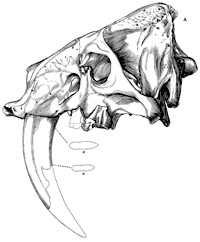Museum, University of Nebraska State

Bulletin of the University of Nebraska State Museum (1924–2023)
Date of this Version
6-1972
Document Type
Article
Citation
BULLETIN OF THE UNIVERSITY OF NEBRASKA STATE MUSEUM, VOLUME 9, NUMBER 6 June, 1972, Pp. 183-195 Frontispiece, Figs. 1-15
Abstract
Evolutionary trends in certain carnivores, rodents, bovids, and proboscideans are examined. Chronoclines are demonstrated for muskrats, beavers, mammoths, and bison. The Pliocene-Pleistocene boundary and Quaternary climatic fluctuations are also discussed.
The University of Nebraska State Museum contains a large stratigraphically controlled collection of Pleistocene animals. This collection provides a unique opportunity for the study of phyletic trends in certain lineages of mammals. Although a few phylogenetic lineages have been proposed (Schultz and Frankforter, 1946; Hibbard, et al., 1965), this has not been done for the vast majority of Pleistocene mammals. However, there is much more data available than this would seem to indicate, and lineages can be suggested for a wide variety of additional mammals, including some which can be projected back into the Pliocene. Reports on some fossil animals from the very Late Pliocene have been published (Tanner, 1960, 1965, 1967; Kent, 1967; Schultz, Schultz, and Martin, 1970). Other studies concerning the Kimballian fauna are presently in manuscript or in press. Schultz, Schultz, and Martin (1971, p. 23-28) include a discussion of the Kimballian and its included fauna which is of prime importance in extending lineages of Pleistocene mammals back into the Pliocene.
Paper presented at VIII International Congress of INQUA (INTERNATIONAL UNION FOR QUATERNARY RESEARCH} at the Nouvelle Faculte de Droit, University of Paris, Paris, France, on August 31, 1969.
Included in
Entomology Commons, Geology Commons, Geomorphology Commons, Other Ecology and Evolutionary Biology Commons, Paleobiology Commons, Paleontology Commons, Sedimentology Commons


Comments
Copyright 1972 University of Nebraska